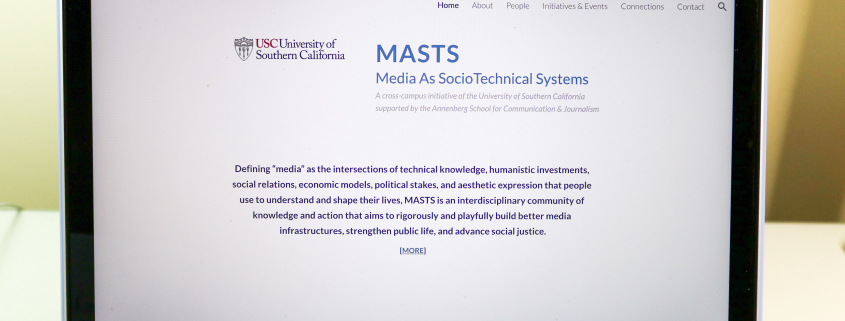A new research group collective explores the intersection of media, technology and social issue

Students from engineering, cinema and communication fields filled the seats of Annenberg Hall in Mike Annany and Colin Maclay’s Annenberg School of Communication and Journalism class “Media, Algorithms, and Platform Publics: Exploring dynamics of design, creation, and practice.” Annany and Maclay created the class in 2017 with an intent to explore the interdisciplinary nature of the digital world. Once the class came to an end, its versatile energy left students and faculty itching for more.
“At the end of the class there was actually this moment where everybody was like ‘Well, we don’t want this class to end, so what do we do?’” said Annany, an assistant professor at Annenberg.
This desire inspired Ananny and Maclay, the latter a professor and executive director of the Annenberg Innovation Lab, to transform the class’ framework into a research group collective, MASTS, that meets weekly on Tuesday afternoons. MASTS stands for Media as SocioTechnical Systems and represents the bridge between media, technology and social issues. Each week, a member of the group presents about an aspect of technology that interests them.
“There’s been a range of topics,” said Adrienne Adams, a graduate student studying American studies and ethnicity and a member of MASTS. “The last few weeks we’ve been thinking about platform governance … coming up I will be speaking about 20th century technology, like faxing, the printer and things like that.”
No matter who starts the discussion, every member has a chance to give their insight and share their perspectives on the issue. Bita Tanavoli, a junior majoring in communication, said that after the presenters explain their topic, there is a whole group discussion that lasts about an hour. Tanavoli also added that the discussions are “very engaging and dynamic.”
Members of MASTS can also use the space to explore topics they might want to eventually discuss outside of the group, Annany said. When someone is planning on presenting at an academic workshop or conference, they can test their ideas in a meeting.
“There’s upcoming [academic workshops and] conferences, where students want to, kind of like test drive presentations or projects that they might take about at those conferences,” Annany said. “Our weekly meetings become places to kind of rehearse or figure out what that topic looks like for them or what a project looks like.”
Over the summer, the surge of Black Lives Matter protests evoked a shift in the undertones of some of the topics MASTS discussed at the time, Annany said.
“Very quickly, a lot of the work had a stronger social justice framework to it,” Ananny said. “Questions of [sociotechnical systems] often have questions of race, and social justice and inequality baked into how they’re designed or how they’re deployed or how money is made off of them. A lot of the group really had a strong social justice and specifically racial justice component to their work where we ask, how do these technologies see people?”
Adams said they focus a lot on Black studies, transgender studies and technology in their classes at USC. MASTS is a perfect place for them to put all of these aspects together.
“It’s kind of this no pressure environment to learn more about things I might have exposure to or work out ideas that I’m thinking about in terms of how Blackness and transness inform the ways that we think about and utilize communication and information technologies,” Adams said.
Because of the coronavirus, MASTS is currently meeting over Zoom. However, the virtual setting has not stopped the group from creating a sense of camaraderie and building close connections, Ananny said. As a first year doctoral student at USC, Adams joined MASTS in October after searching for a way to meet students with similar interests, such as the large role of technology in society.
“I think my favorite thing has been … just getting to know people from so many other departments,” Adams said. “There’s former postdocs who are now professors, there are people from cinema, media studies, there’s people from my own department — Annenberg —and there seems to be this really dynamic approach every time we have a conversation because there’s so many different backgrounds.”
Ananny echoed Adams’ feelings towards the group, especially since he was unsure whether the group’s connection would be as rich as if the meetings were in person.
“People wanted to keep meeting,” Annany said. “The attendance of the meetings went up over the summer, it went up in the fall. This feeling of, ‘Oh, people are becoming disconnected,’ if anything we saw the exact opposite. People were craving the interdisciplinary community that had motivated us at the very beginning.”
In the coming weeks, the group will be focusing on background infrastructures, such as transit systems and Bluetooth. Ananny looks for MASTS to expand this semester to include more people from various disciplines at USC.
For Tanavoli, she looks forward to continuing learning from the diverse perspectives of the group.
“For now, I’ve been having a great time just listening and learning and getting to know new people,” Tanavoli said.

